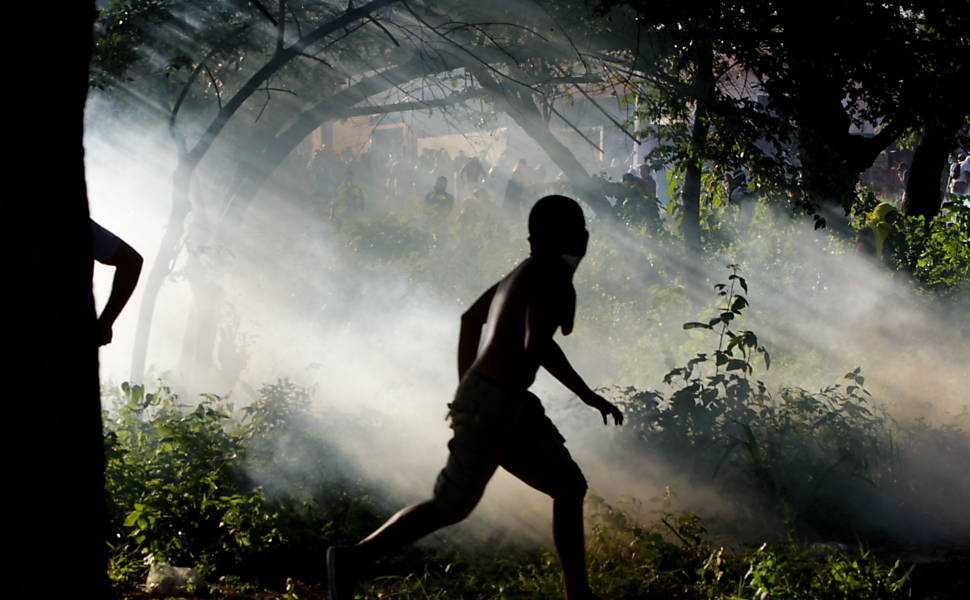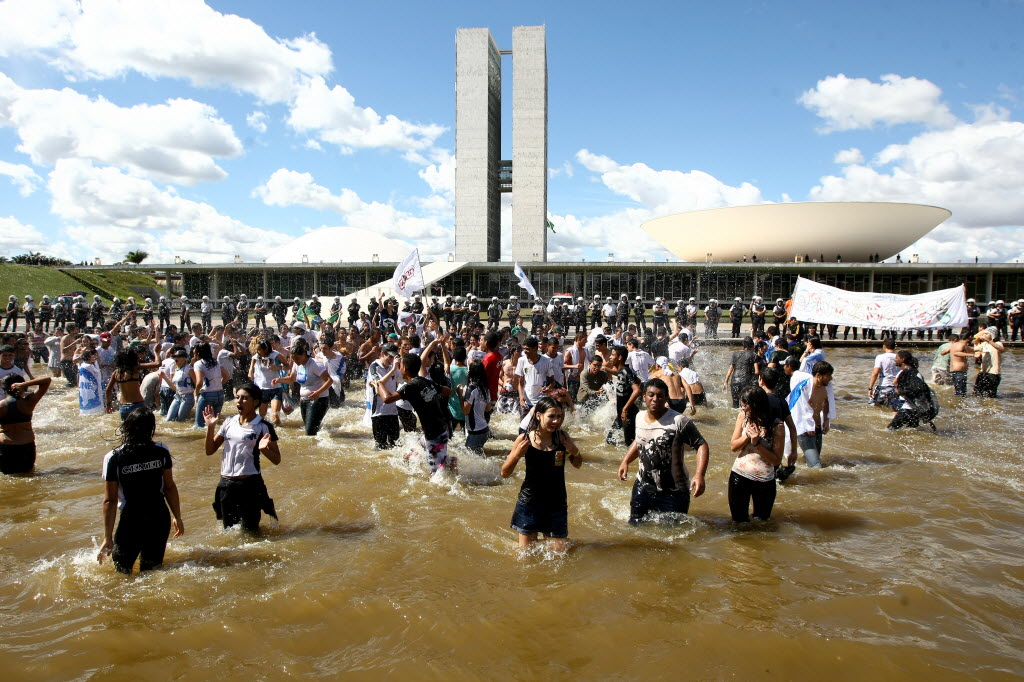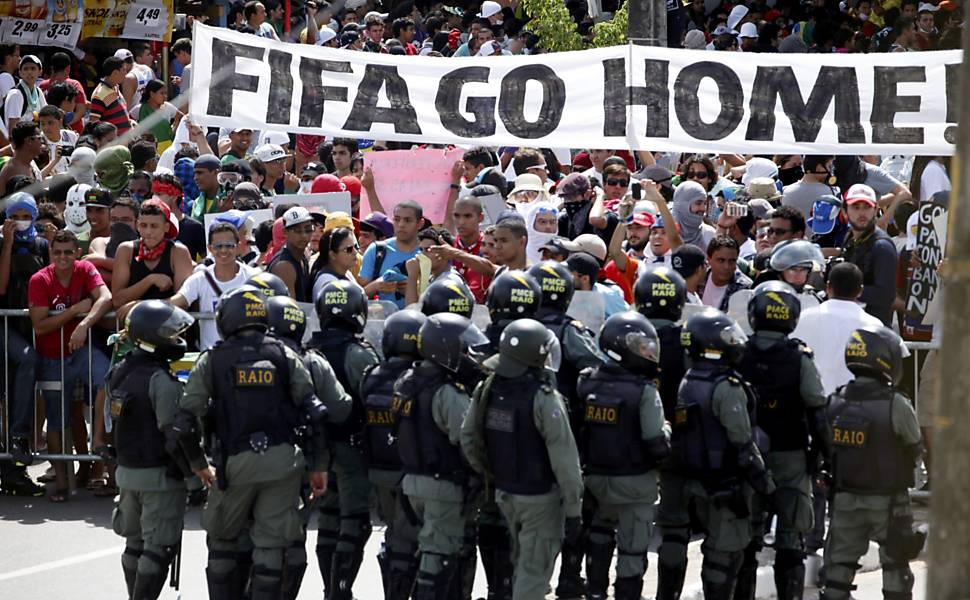Things that seemed impossible less than a month ago are now happening every day here in Brazil. In a political Big Bang of swirling movements, causes and new protagonists, a new Brazilian universe is taking shape. Above, protestors in front of Congress, Brasília.
By Claire Rigby
Thousands of column inches have already been written on recent events in Brazil, and more are surely being written as I write these. Nobody could have predicted, on 3 June, the day of the first in the series of protests organized by the Movimento Passe Livre (MPL, Movement for Free Public Transport), that events would take this turn, impelling a political and social Big Bang from which the fall-out is still spiraling, stars colliding and new bodies emerging in the Brazilian sky.
The protests and their aftermath have given rise to a cast of thousands and indeed, millions, in what is perhaps the most profound effect of the unrest: the sudden political protagonism of huge swathes of formerly passive citizens, on the street and on social networks – mainly Facebook. The site has come into its own brilliantly as a public–private forum for discussion and planning, for real-time reporting, and for registering protests, repression, meetings and assemblies in text, film, photos and audio.
Less than a month ago, as noted by Samantha Pearson in yesterday’s FT, two of the main slogans of the multi-sloganed protests, ‘The giant has awoken’ and ‘Vem pra rua‘ – ‘Come to the streets’ – were most famous as straplines for Johnnie Walker and Fiat TV ads, respectively. And even if, in the weeks preceding the slow-building explosion of people onto the streets to demonstrate, hundreds of images and texts were being shared here about the protests and repression in Taksim Square, Istanbul, there was nothing to suggest that Brazil might be next.
Less than a month ago, the Confederations Cup was already looming large, but the idea of there being protests associated with it was nowhere near the agenda. ‘Imagina na Copa‘ (meaning ‘if it’s this bad now, imagine what it will be like in the World Cup’), a catch-all phrase for structural problems large and small, was little more than a collective, anxious fretting over the World Cup, and the likelihood of Brazil’s infrastructure being ready for it. But it is now linked to protests and skirmishes outside the stadiums, and to discontent with what’s perceived as massive over-spending as well as bad planning for the Cup.

As I write this, in the streets of Fortaleza, North-East Brazil, where the Confederations Cup match between Italy and Spain is underway, a ‘sonic cannon’ crowd-control weapon has just been switched on for the first time by police, and protests have turned to tyre-burning on the parts of protestors, and tear-gassing and shooting on the part of the police. Witness this Storify of the days’ events in Fortaleza, which shows protesters with a FIFA GO HOME banner, police firing smoke bombs and teargas, and protesters scattering, their faces covered. One tweet by @KetyDC, whose feed is a tireless, compelling ticker-tape covering protests all over Brazil, reads ‘Palestine? No, Fortaleza. #ProtestoCE #VemPraRua #ChangeBrazil (AFP) ‘.
And in an example of the hundreds of causes spiraling off from or piggy-backing the protest movement and its original demand for a reduction in the cost of public transport, another image on the Storify shows a set of designer-sunglass-wearing, bermuda-shorted young men holding signs reading, ‘Political Reform Now!’ That call for political reform, not a issue in the original protests except, arguably, in the most peripheral way, has been in the mainstream political pipeline for some time now, and its revival has become one of the ways in which Brazil’s government – federal, state and municipal – is scrambling to accommodate (or be seen to accommodate) protestors’ perceived demands.
On 25 June, President Dilma Rousseff announced a five-point plan for change that included public consultation on political reforms. In vintage Brazilian style – the level of bureaucracy in Brazil, for even the simplest piece of business, is daunting – Dilma’s announcement contained half-a-dozen procedural steps to get to the matter at hand: a proposal for ‘a debate over the convening of a plebiscite to authorize the functioning of a constituent process to carry out the reform’.
The ‘debate’ on that lasted less than 24 hours, and Dilma, along with the rest of government, is now looking at simply calling a plebiscite on reform. (The political reform in question is twofold, covering the way elections should be funded [Dilma’s party, the PT, wants them to be publicly rather than privately funded], and whether the currently proportional voting system should be changed to voting on the basis of districts [the PT, a relatively small party, would prefer it to stay as it is].)
Who’s who
As for the sunglass-wearing protestors in the Storify, they’re an example of the multiplicity of actors now onstage all over Brazil, on the streets and online, making their voices heard. A battery of assemblies, meetings, demos and street battles is going off on all sides, in city centres and across their peripheries, in an atmosphere in which working out who is who has become almost comically difficult at times. On Tuesday night, I attended a public assembly about the democratization of the media, held underneath the looming hulk of the MASP museum on São Paulo’s Avenida Paulista. As a speaker was proposing ‘agrarian reform of the airwaves’, a march approached along the avenue, and drawing level, stopped. The two groups regarded each other with a mix of curiosity and suspicion for a few moments, trying to get the measure of one another.
‘Vem pra rua!’ called the marchers, unsure what kind of assembly they had stumbled upon. The assemblists regarded them silently, sizing up the placards, noticing the Brazilian flag around one pair of shoulders, wondering. Eventually, with an expression of solidarity, the speaker holding the microphone deftly sent them on their way, albeit a little uncertainly, and picked up where he’d left off.
The confusion is understandable: lots of things aren’t what they seem, and others seem not to be what they are. Some young men in Occupy-style Guy Fawkes masks turn out to be rightist agitators, hurling abuse at left-wing parties on 20 June, when a PT march was routed from Avenida Paulista. A photo of an unlikely burly, white-shirted and masked rioter who stood out from the crowd, piling in at São Paulo’s City Hall and smashing at the door, was suspected by protestors of being an infiltrator and a provocateur, but turned out to be an over-enthusiastic architecture student. A ‘General Strike’ event on Facebook, since removed, with at least 700,000 confirmed attendees, was found to have been called not by workers’ movements, but created by a single person: a man named Felipe Chamone, an amateur marksman who appeared photographed bearing a gun, triggering a counter-event on Facebook, ‘Denouncement of the General Strike event‘. Even more confusingly, a group of unions now apparently has called a general strike, for 11 July…
‘Think hard,’ reads the page urging people not to join the General Strike event, ‘before you join any event related to the protests, even if your participation is only symbolic or virtual. Make yourself aware of who is responsible for the initiative, and whether it aligns with your convictions.’ Given that less than a month ago, out of the hundreds of thousands of people who have now taken part in the protests, many would have displayed little reaction to news of a protest other than a loud tut at the disruption to traffic, it’s to be hoped that the habit of critical thinking, developed during these first weeks of the movement, will persist.
For now, as various strains of conservatism scramble to contain, co-opt, appease and control what parts of the movement they can, the Movement for Free Public Transport (MPL), having met with Dilma this week (and having declared her to have a woeful lack of knowledge about transport), is moving onto its own real agenda. Hint: the clue’s in the group’s name, and in its slogan, ‘For a life without turnstiles’. Having achieved the 20¢ reduction in bus fares it took to the streets for at the start of June, the MPL is continuing to campaign for universal free public transport, a gateway right, its activists claim, without which many other rights – to hospital treatment, to education, to culture – are impossible for people to exercise.
Walk this way
In an open letter to Dilma in advance of its meeting with her this week, the MPL wrote about a range of other issues beyond transport, including the militarization of the police, the plight of Brazil’s indigenous peoples, and the ongoing repression and criminalization of social movements. It might be a logical progression, too, for an overtly anti-car current to emerge in or around the MPL. There’s no apparent sign of it yet (though the MPL’s open letter refers to an eleven-times greater public investment in individual than in public transport).
But given a set of factors, in São Paulo at least, that include chronic traffic gridlock, a vocal cycling activist lobby, a horrifying death toll annually on the roads, and the sharp focus on transport nationwide, a serious critique of cars and car culture would be an interesting development, to say the least. Coming in the wake of growing demands and actions here in São Paulo for people to ‘occupy the streets’ together, in the form of festivals, demonstrations and other events, the wave of recent protests managed to sweep cars from the picture effortlessly, banishing them from the scene in a single stroke and filling the streets with throngs of people, walking in unison.
There’s even a ready-made slogan, crying out to be appropriated – it’s the punchline of that Johnnie Walker TV ad: Keep Walking, Brazil.
Follow @claire_rigby on Twitter



